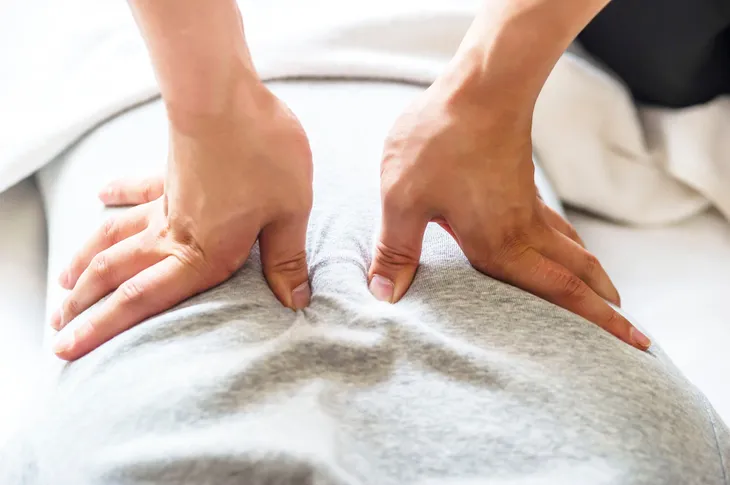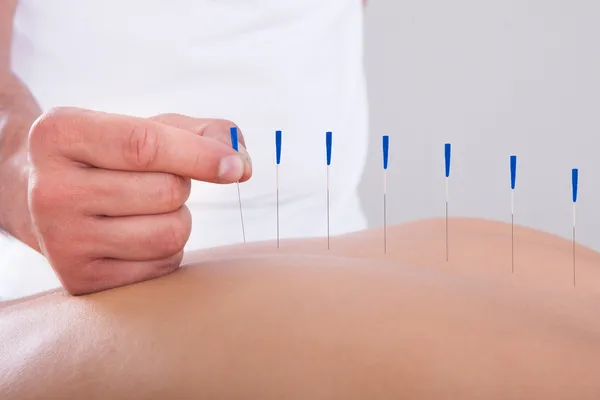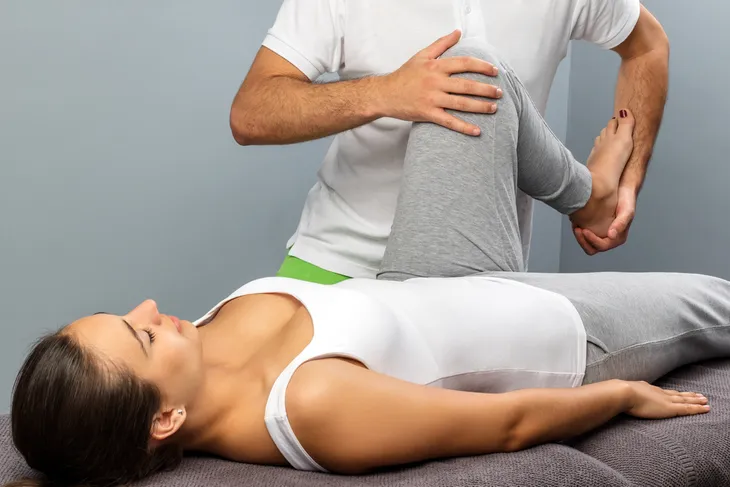You can’t help but notice the biting, shooting pain that comes with sciatica. This condition affects the sciatic nerve that runs across the buttock and down the back of the legs (the entire length of the hamstrings to the toes).
When the sciatic nerve pain acts up, the nerve itself becomes inflamed due to an injury—for instance, a slipped disc, pinched nerve, pressure due to pregnancy, or poor posture. Sciatica can be very debilitating; however, there are a few tricks that can help soothe sciatic nerve pain and decrease inflammation.
Here are 15 tips for relieving sciatica…
1. Massage
Massaging the muscles of the buttocks and backs of the legs (where the sciatic nerve runs) can loosen muscle tension and decrease painful nerve inflammation. How? Massage promotes blood circulation which will ease sciatic nerve tenderness and built up tension.
2. Apply Hot and Cold
The old hot and cold switch works wonders on sciatic nerve pain. Start by applying an ice pack to decrease sciatic nerve inflammation then follow up directly with a heating pad to soothe muscle tension and encourage blood flow to the tense muscles and nerves in the area at the backs of the legs and buttocks.
3. Pain Killers
Pain killers are quite effectively procured over the counter at most local drug stores. Concentrate on pain relievers for muscle tension, such as aspirin or ibuprofen. These will work to help eliminate the painful inflammation associated with chronic sciatica.
4. Acupuncture
Traditional Chinese acupuncture employs tiny needles inserted into specific pressure points on the body to ease pain and inflammation. Acupuncture has been shown to lessen the painful muscle spasms caused by sciatica. This Eastern treatment also encourages blood flow and circulation in the backs of the legs, lower back, and buttocks.
5. Prescription Medications
Chronic sciatic nerve pain may have you rushing to the doctor for prescription aid. In many cases, doctors will prescribe medications to treat sciatica, including muscle relaxants, higher dose pain killers, and even anti-depressants (to encourage endorphin production).
6. Stretching
Stretching or yoga can encourage tight muscles to loosen up. Promoting flexibility through stretching can ease sciatica by also improving lower back support and improving core strength. This way, less pressure is placed on the backs of the legs where the sciatic nerve resides.
7. Topical Ointments
Rather than pain relievers taken orally, many sciatica patients prefer to apply a topical pain relieving ointment directly to the inflamed area. These pain relieving gels (usually called analgesics) often contain menthol, an ingredient that blocks pain receptors and relaxes stiff muscles.
8. Back Support Aids
If you sit all day long in an uncomfortable office chair, you’re only exacerbating the sciatic nerve and causing greater inflammation and stiffness. It’s worth investing in a desk chair with sturdy support and a balanced surface to promote posture while reducing pressure on the lower back and upper buttocks.
9. Physical Therapy
Physical therapy in combination with massage will loosen tense muscles, encourage blood flow, and promote fuller range of motion and flexibility. Physical therapies will prescribe specific exercises and postures to lessen chronic sciatic nerve pain.
10. Hydrotherapy
Applying heat with a heating pad is alright but immersing your sore body in a hot tub or Jacuzzi bath is heaven. Hydrotherapy not only lessens muscle stiffness and inflammation, but also actually promotes circulation, which will help soothe chronic sciatic muscle spasm.
11. Chiropractic Care
As mentioned in the introduction, sciatic nerve pain can sometimes be caused by a slipped or herniated disc. If that’s the case, then seeing a chiropractor may be one of the best remedies for relieving pain.
In fact, the Official Journal of the North American Spinal Society published a study that involved 102 adults with sciatic nerve pain. Dr. Axe explains that the study found that “those who received chiropractic adjustments experienced less local pain, fewer number of days with pain, and fewer cases of moderate or severe pain compared to people who didn’t receive adjustments.”
12. Bed Rest
In some cases of sciatica, rest may be the best medicine. WebMD indicates that three days tends to be enough, during which “it’s important to be on a firm mattress or the floor.“
While it may be tempting, be sure not to overdo this resting period. As Spine-Health.com explains, “[…] Avoiding activity any longer can typically lead to a downward spiral where episodes of pain lead to inactivity, leading to more pain, and so on.” So while a few days off your feet may not completely alleviate the pain, it’s important to get up and moving again in order to prevent even more pain from occurring.
13. Exercise
Speaking of getting up and moving, exercise is important for reducing sciatic nerve pain. Although it may be the last thing you feel like doing when you’re in pain, “Exercise increases blood flow to the disk and the nerve, helping get rid of the chemicals causing the inflammation,” says physical therapist Birgit Ruppert, in speaking with Prevention.
The source suggests taking short walks (about 15 to 20 minutes long) or getting in the pool to swim or aerobic exercises, as “there’s not as much pressure on the back when you’re in the water.”
14. Epidural Steroid Injections
For some, the methods already mentioned on this list may prove ineffective for relieving their sciatic nerve pain. In such cases, more intensive therapies may need to be employed, such as epidural steroid injections.
These injections are inserted in the lower back, close to the sciatic nerve, and are intended to help reduce inflammation. They tend to only be prescribed for those whose pain persists for a month or longer, and for whom other common remedies haven’t helped. Steroid injections are also limited to three per year due to their potentially harmful side effects, such as loss of bone density.
15. Surgery
While, in most cases sciatic nerve pain can be alleviated through the tips mentioned here, for some the only effective method is surgery. This only tends to be necessary for about 5 to 10-percent of affected individuals, who experience persistent pain for a period longer than three months.
There are two main types of surgery for sciatica: discectomy and laminectomy. With discectomy, WebMD says, “[…] Your surgeon removes whatever is pressing on your sciatic nerve, whether it’s a herniated disk, a bone spur, or something else.” With a laminectomy, the lamina—part of the bone structure that surrounds the spinal cord— is removed, as well as “any tissue pressing on the nerve that’s causing you pain.”


















